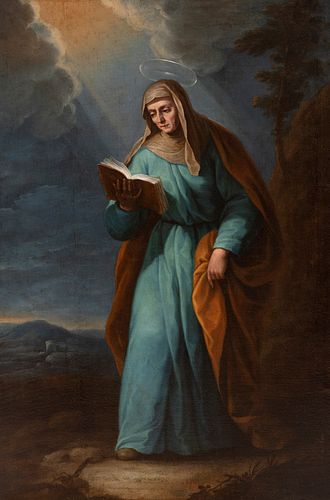Madrid School; early eighteenth century. "Saint Anne. Oil on canvas. Relined.
Lot 58
About Seller
Setdart Auction House
Carrer Aragó 346
Barcelona
Spain
Setdart Subastas was born in 2004 and is currently the first online art auction in Spain with solidity, prestige and reliability guaranteed by our more than 60,000 users. Setdart has a young, dynamic and enterprising team ready to successfully manage the purchase and sale of art works through custom...Read more
Estimate:
EUR€9,000 - EUR€10,000
$9,677.42 - $10,752.69
Absentee vs Live bid
Two ways to bid:
- Leave a max absentee bid and the platform will bid on your behalf up to your maximum bid during the live auction.
- Bid live during the auction and your bids will be submitted real-time to the auctioneer.
Bid Increments
| Price | Bid Increment |
|---|---|
| EUR€0 | EUR€10 |
| EUR€200 | EUR€25 |
| EUR€500 | EUR€50 |
| EUR€1,000 | EUR€100 |
| EUR€3,000 | EUR€200 |
| EUR€5,000 | EUR€500 |
| EUR€10,000 | EUR€1,000 |
| EUR€20,000 | EUR€2,000 |
| EUR€50,000 | EUR€5,000 |
About Auction
By Setdart Auction House
Nov 3, 2021
Set Reminder
2021-11-03 08:00:00
2021-11-03 08:00:00
America/New_York
Bidsquare
Bidsquare : OLD MASTERS
https://www.bidsquare.com/auctions/setdart-auction-house/old-masters-7786
Setdart Auction House sofia@setdart.com
Setdart Auction House sofia@setdart.com
- Lot Description
Madrid School; early eighteenth century. "Saint Anne. Oil on canvas. Relined. It has a frame from the early nineteenth century. Measurements: 125 x 83 cm; 137 x 84 cm (frame). The artist uses in this work an apparently simple composition, placing the Saint in the center of the scene, surrounded by a landscape. However, by introducing the break of glory, the luminosity of the same that is directed to St. Anne, breaks with the verticality of the figure of the saint. The presence of the book, her nimbus of sanctity, and the wrinkles on her face, make it evident that this is the representation of the mother of the Virgin. She is responsible for instructing the mother of Christ, hence the presence of the book. The Madrid school emerged around the court of Philip IV first and then Charles II, and developed throughout the seventeenth century. Analysts of this school have insisted on considering its development as a result of the agglutinating power of the court; what is truly decisive is not the place of birth of the different artists, but the fact that they were educated and worked around and for a nobiliary and religious clientele located next to the royalty. This allows and favors a stylistic unity, although the logical divergences due to the personality of the members can be appreciated. In its origin, the Madrid school is linked to the rise to the throne of Philip IV, a monarch who made Madrid, for the first time, an artistic center. This meant an awakening of the nationalist conscience by allowing a liberation from the previous Italianizing molds to jump from the last echoes of Mannerism to Tenebrism. This will be the first step of the school, which in a gradual sense will walk successively until the attainment of a more autochthonous baroque language and linked to the political, religious and cultural conceptions of the monarchy of the Austrias, to go to die with the first shoots of the rococo that are manifested in the production of the last of its representatives, A. Palomino. The techniques most used by these painters were oil and fresco. Stylistically, they start from a naturalism with a notable capacity for synthesis to opportunely lead to the allegorical and formal complexity characteristic of the decorative baroque. These artists show a great concern for the studies of light and color, as we see here, highlighting at first the games between extreme tones typical of tenebrism that later will be replaced by a more exalted and luminous colorism. They receive and assimilate Italian, Flemish and Velázquez influences. The clientele will determine the fact that the subject matter is reduced almost exclusively to portraits and religious paintings.
- Shipping Info
-
In-house shipping available. Please inquire at admin@setdart.com.
-
- Buyer's Premium



 EUR
EUR CAD
CAD AUD
AUD GBP
GBP MXN
MXN HKD
HKD CNY
CNY MYR
MYR SEK
SEK SGD
SGD CHF
CHF THB
THB

















